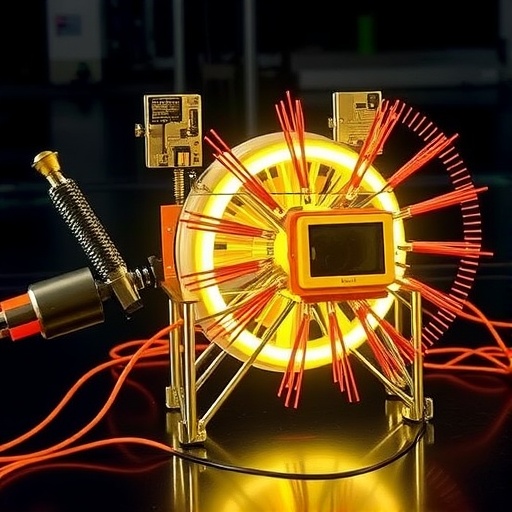In an era where technological advancements shape every facet of life, researchers are continuously exploring innovative ways to replicate and enhance traditional systems. One of the latest explorations comes from a study that dives deep into the realm of oscillatory systems, shedding light on the electronic equivalents of mechanical impact oscillators. This fascinating research, dated 2025, centers around the intricate interplay between mechanical and electronic systems, revealing profound implications for future technologies.
Mechanical impact oscillators have long been recognized in various applications, including clocks, pressure sensors, and energy harvesting devices. These systems harness potential energy through their oscillatory nature, making them efficient tools for converting energy from one form to another. However, as technology progresses, there arises an inherent desire to create electronic counterparts that emulate these mechanical systems with greater precision and efficiency.
The study, conducted by an accomplished team, including Denysenko, Balcerzak, and Dabrowski, meticulously explores how these electronic equivalents can be designed and optimized. Researchers aimed not just to mimic mechanical oscillators but to enhance their performance beyond traditional limitations. This ambition reflects the larger trend in engineering and physics, where the boundaries of what is possible are continuously pushed.
The researchers employed advanced computational models to simulate the behavior of mechanical impact oscillators. Through these simulations, they gained insight into the parameters that dictate the performance of these oscillatory systems. By analyzing how various physical properties, such as mass and stiffness, affect the system’s dynamics, they were able to derive critical lessons applicable to electronic designs.
A pivotal aspect of this research was the implementation of feedback mechanisms that improve oscillatory stability. In mechanical systems, such feedback is often achieved through springs or dampers. However, in the electronic domain, the challenge lies in replicating this behavior without the physical constraints and nonlinearities present in traditional systems. The research team unveiled innovative electronic circuits that could function analogously to mechanical feedback devices, providing the necessary stability while maximizing efficiency.
The implications of these findings are manifold. In industrial applications, the ability to create miniature electronic versions of larger mechanical oscillators could lead to more compact and energy-efficient devices. This aspect is particularly important for wearables and mobile devices, where space and power consumption are critical constraints. Imagine smartwatches and fitness trackers that incorporate these advanced oscillatory systems for more accurate monitoring of physical activities.
Moreover, energy harvesting technologies may take a giant leap forward thanks to this research. Mechanical oscillators often operate on the principle of converting kinetic energy into electrical energy. With the advent of these electronic equivalents, researchers anticipate a surge in energy-efficient solutions that can generate power from ambient vibrations, movement, or sound. Such advancements could revolutionize how we harness energy in urban environments, where noise and vibrations are ubiquitous.
As we delve further into the specifics of the electronic equivalents, the study highlights a range of design principles that researchers can adopt. For instance, the integration of MEMS (Micro-Electro-Mechanical Systems) technology presents an exciting opportunity for combining mechanical vibrations with electronic control. This hybrid approach could enhance system responsiveness and reduce energy consumption, bridging the gap between mechanical efficiency and electronic speed.
The research also indicates potential applications beyond consumer electronics. In the domain of robotics, for instance, these electronic oscillators can provide enhanced motion control, enabling smoother and more precise movements. As robotic systems become increasingly sophisticated, having reliable oscillatory mechanisms will be essential for tasks ranging from delicate surgical procedures to autonomous navigation.
In terms of educational implications, the findings pave the way for new curricula focusing on the convergence of mechanical engineering and electronics. Students in the fields of physics and engineering will benefit from understanding both the classical mechanics of oscillators and the modern electronic adaptations. This synergistic knowledge will prepare future engineers to tackle multi-disciplinary challenges, ensuring they can innovate across traditional boundaries.
As the research community continues to underscore the importance of interdisciplinary approaches, this study stands as a testament to the creative minds that bridge the gap between mechanical and electronic disciplines. By leveraging simulative modeling and executing a detailed examination of system behaviors, the authors of this study push the envelope of what is achievable.
Going forward, the potential for real-world applications of these electronic impact oscillators is staggering. From enhancing the performance of sensors used in environmental monitoring to improving the technology in musical instruments, the possibilities are endless. Researchers firmly believe that, as is so often the case with groundbreaking discoveries, the implications of their work will extend far beyond the initial goals of their study.
To sum up, the exploration of electronic equivalents of mechanical impact oscillators unveils an exciting frontier filled with promise for enhancing existing technologies and pioneering new applications. As research progresses and innovations emerge from these findings, we can anticipate a future where electronic oscillatory systems play a pivotal role in various sectors, transforming how we interact with and utilize the technology around us.
Subject of Research: Electronic equivalents of mechanical impact oscillators.
Article Title: Electronic equivalent of a mechanical impact oscillator.
Article References: Denysenko, V., Balcerzak, M. & Dabrowski, A. Electronic equivalent of a mechanical impact oscillator. Sci Rep 15, 39853 (2025). https://doi.org/10.1038/s41598-025-23489-8
Image Credits: AI Generated
DOI: https://doi.org/10.1038/s41598-025-23489-8
Keywords: electronic oscillators, mechanical impact oscillators, energy harvesting, MEMS technology, interdisciplinary research, robotics, advanced technology.
Tags: advancements in oscillatory technologiescomputational models in researchElectronic impact oscillatorsenergy harvesting innovationsenhancing performance of oscillatory devicesfuture technologies in engineeringimplications of electronic oscillatorsinterdisciplinary research in technologymechanical vs electronic systemsoptimization of electronic oscillatorsprecision in mechanical systemsreplicating mechanical oscillators





